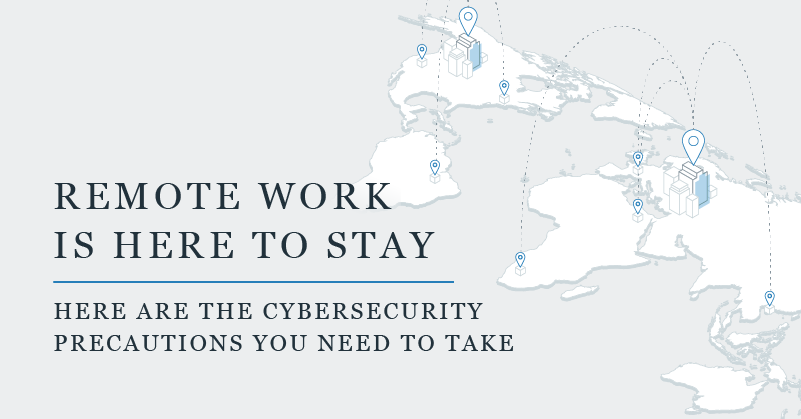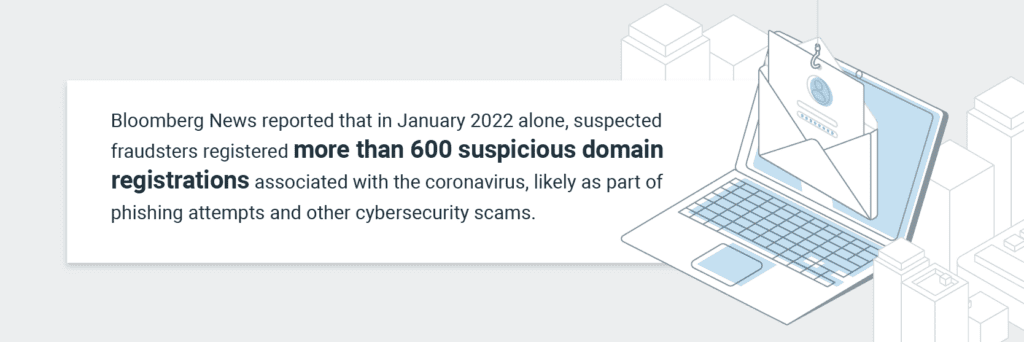
In workplaces around the world, the COVID-19 pandemic accelerated the shift to work-from-home arrangements. Simultaneously, cybersecurity concerns proliferated at an alarming rate. Bloomberg News reported that in January 2022 alone, suspected fraudsters registered more than 600 suspicious domain registrations associated with the coronavirus, likely as part of phishing attempts and other cybersecurity scams.

There’s reason to believe that remote work will be a permanent fixture of business life for the coming years. With that reality, we can expect to see a continued rise in security issues for the foreseeable future. As highly controlled, more secure corporate networks are increasingly displaced by dispersed teams, home networks, cloud-based storage and collaboration tools, what does it take to keep your company safe?
The problem: Cybersecurity trends have gained prominence during the pandemic
As the COVID-19 pandemic unfolded, cybersecurity experts noted emerging trends. In some cases, there was an acceleration of familiar techniques, like ransomware and phishing. In others, the rush to embrace new technology to support remote working needs meant that organizations sometimes neglected traditional security best practices.
Phishing emails
Phishing emails aren’t new, but the coronavirus pandemic provided an attractive opportunity and new motivations for this malicious activity. The millions of fraudulent communications associated with COVID-19 were a rapid escalation of a long-standing tactic. According to Barracuda Networks, the number of phishing scams related to COVID-19 surged by 667% in March alone. Meanwhile, Google revealed it was blocking more than 18 million malware and phishing emails related to COVID-19 every day.
Many workers were operating under new constraints and in unfamiliar environments, making them more susceptible to these kinds of attacks. In a test performed in late March, researchers found that users are three times more likely to click on a phishing link and then enter their credentials than they were pre-COVID. With incentives like the chance to file fraudulent unemployment claims after harvesting information from unwitting victims, attackers had every reason to move quickly.
Given the widespread proliferation of phishing attacks, and their enduring appeal for attackers, there’s no reason to believe they’ll be going away anytime soon. The message may change to keep up with the times, but the same basic principles will still apply.
Collaboration tools
Videoconferencing has become a staple of the new work-from-home setup. Without the chance to meet in person, many businesses quickly embraced video calls as an alternative to in-person meetings among colleagues and with outside clients, partners and associates.
However, it didn’t take long for so-called Zoom bombing incidents to take off. Many of these incursions were simply disruptive and annoying. Others contained a barrage of offensive material. However, far from simply being an avenue provoking disorder, unauthorized access to private meetings is a business liability. For example, consider what happens if an intruder can glimpse private information discussed during a meeting related to an upcoming merger or acquisition. The disclosure of such information to the public can have significant implications to the business.
Since videoconferencing is here to stay, it’s important to tighten security measures (e.g., restricting access to only company domains, enforcing meeting entry codes/passcodes, etc.) around virtual meetings, as well as other collaboration tools. We’ve seen that there’s no shortage of willing participants to enter any conversation uninvited.
Possible solutions: Important protective measures for the new threat landscape
Knowing what we do now, there are many crucial steps that companies can take to help safeguard against the shifting threat landscape. These precautions will be essential for the rest of the pandemic and in the new workplace environments that will follow.
Organizational improvements
At the enterprise level, there are several important techniques and policies that organizations can leverage and institute, such as:
Continuous monitoring
Constant assessment of your organization’s overall security state, using automation, can help you uncover issues before they turn into a problem.
Up-to-date software
Effective, regularly updated antivirus and anti-malware solutions are essential tools.
Asset and endpoint protection
Ensure that vital devices and hardware have continuous backup enabled, and verify that the latest antivirus protections are installed.
Endpoint detection and response (EDR)
Use EDR solutions to monitor for potential threats against individual devices in real time.
Encryption
Decide which hard drives and other endpoints need to have their data encrypted as a security measure.
Employee and contractor education
Create a formal program for training workers in how to identify, report and respond to potential threats.
Heightened worker awareness
Workers need to have a high level of understanding about the threat landscape and a clear sense of your organization’s cybersecurity policies and best practices, including:
Basic network security
Individuals who work from home need to acknowledge the importance of using only secured networks, like properly configured home Wi-Fi that uses a unique, strong password.
Policies around virtual private networks (VPNs)
Some organizations require individuals who work remotely to use a VPN in order to access company systems and resources. Make sure staff members know what this means and how to follow the guidelines.
Training to spot phishing
Make sure personnel can identify the warning signs of a phishing attempt, such as phrasing that is intended to generate a sense of urgency or request of sensitive personal information (e.g., social security number). Furthermore, workers should know how to properly report phishing attempts to respective security teams within their organization.
Support for secure logins
Empower your workers with secure authentication mechanisms such as single sign-on (SSO) and multifactor authentication (MFA).
Knowledge of secure data transfer
Ensure that individuals use only secure, approved collaboration tools instead of taking shortcuts with unauthorized channels, especially for transmitting sensitive documents.
Social media savvy
Institute clear policies and guidelines for keeping company data and sensitive personal information off of social media — where it could be scrubbed and used to execute attacks against the organization.
Conclusion
While the COVID-19 pandemic isn’t over yet, it’s likely that the trend toward distributed workforces is here for good. That means businesses will have to continue to contend with a permanently altered threat landscape.
The experts at CFGI can help you assess the impact of new and emerging risks so you can better mitigate issues and strategize about how to move forward confidently in the new normal. Schedule a free 30-minute consultation with our team today to learn more.
